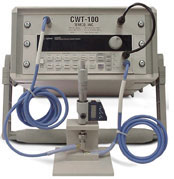The Continuous Wave Technique (CWT) methodology was introduced in 1996 by IKU Petroleum Research (now SINTEF Petroleum Research) as a method for measuring the acoustic velocities on small core samples, including in particular shale drill cuttings. The CWT technology is a fast and inexpensive method of measuring the ultrasonic wave velocity on samples as small as sub-millimeter in thickness. This instrument can be used at the rig site or in the laboratory.
Features
Patented – Proven Instrument
Portable
Fast and Easy to Use
Testing of Small Samples
Testing of Drill Cuttings
Source of Information on Formation Properties
Quasi Real Time Data at the Rig Site
Acoustic Primary-wave (P) Phase Velocity
Ultrasonic Frequency
Applications
Estimation of Mechanical Properties of Rocks from velocities
Estimation of Seismic Parameters
Estimation of Pore Pressure
Detection of High-Pressure Zones
Prediction of Bore Hole Stability
Drillability of Formation
Optimization of mud composition in Shale intervals
Measurement of core properties from core fragments when sufficient core material cannot be retrieved from a well to conduct conventional plug experiments.
Estimation of the mechanical properties of drill cuttings, including shale, from the measured velocities. Such correlations may allow for the tuning of the mud weight to prevent borehole instabilities during the drilling process. The data may also be used to improve the selection of other drilling parameters.
Estimation of the effects of exposure to various dril ling muds. This is particularly relevant is shale intervals. Since the test samples are small, fluid effects will occur faster, reducing the time required to observe fluid effects in the test core sample.
Estimation of the seismic parameters that are needed as input to interpret seismic data. Sample velocities can thus be provided even in intervals that have not been covered by sonic logs. It can also provide information on the velocity anisotropy.
Estimation of the pore pressure. Velocity data may be used for pore pressure estimation and identification of high-pressure zones.
Presentation of Acoustic Primary (P) wave Phase velocities on cuttings
Features
Patented – Proven Instrument
Portable
Fast and Easy to Use
Testing of Small Samples
Testing of Drill Cuttings
Source of Information on Formation Properties
Quasi Real Time Data at the Rig Site
Acoustic Primary-wave (P) Phase Velocity
Ultrasonic Frequency
Applications
Estimation of Mechanical Properties of Rocks from velocities
Estimation of Seismic Parameters
Estimation of Pore Pressure
Detection of High-Pressure Zones
Prediction of Bore Hole Stability
Drillability of Formation
Optimization of mud composition in Shale intervals
Measurement of core properties from core fragments when sufficient core material cannot be retrieved from a well to conduct conventional plug experiments.
Estimation of the mechanical properties of drill cuttings, including shale, from the measured velocities. Such correlations may allow for the tuning of the mud weight to prevent borehole instabilities during the drilling process. The data may also be used to improve the selection of other drilling parameters.
Estimation of the effects of exposure to various dril ling muds. This is particularly relevant is shale intervals. Since the test samples are small, fluid effects will occur faster, reducing the time required to observe fluid effects in the test core sample.
Estimation of the seismic parameters that are needed as input to interpret seismic data. Sample velocities can thus be provided even in intervals that have not been covered by sonic logs. It can also provide information on the velocity anisotropy.
Estimation of the pore pressure. Velocity data may be used for pore pressure estimation and identification of high-pressure zones.
Presentation of Acoustic Primary (P) wave Phase velocities on cuttings


